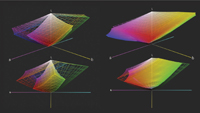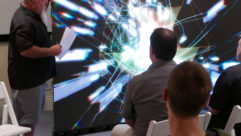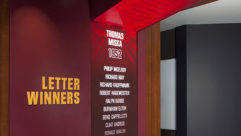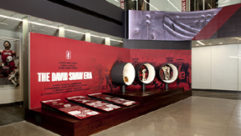

A New Way to Measure Color Brightness
According to color scientist Karl Lang of Lumita, a network of technology and marketing resources for the digital imaging industry, new technology in projectors has created a hole in the color specifications standards by altering the contents that brightness metrics were meant to measure.
ACCORDING TO COLOR SCIENTIST Karl Lang of Lumita, a network of technology and marketing resources for the digital imaging industry, new technology in projectors has created a hole in the color specifications standards by altering the contents that brightness metrics were meant to measure.
According to color scientists at Lumita, when a projector’s color brightness is less than its white brightness, the image produced is less bright as demonstrated by the 3D gamut (translucent solid) and the sRGB color-space (wireframe) on the left. The image on the right shows the 3D gamut (translucent solid) and the sRGB colorspace (wireframe) of a projector with equal color brightness and white brightness.
Credit: COURTESY LUMITA LABS
To fill that hole, Lang and fellow researchers developed a new way for projector manufacturers and AV professionals to measure color brightness using familiar methods. However, not everyone in the projector market is on board with this proposed metric.
Currently, there are two main standards that appear on most projector specification sheets: lumens and chromaticity. The lumens standard measures the amount of brightness projected, which is actually a measurement of white brightness. A chromaticity chart is a triangular diagram that shows the color value of the primaries: red, green, and blue (RGB). “Those two items told you pretty much everything you needed to know about a projector,” Lang says, “because it told you the color of RGB and, when you combined the colors together, how bright white was.”
While input signal sources such as DVD players and computers assume that the RGB quantity equals white, this is not necessarily true in more advanced projectors because manufacturers often add white and additional colors to the RGB. “When red, green, and blue don’t add up to white, the color that is specified in the input signal is not reproduced correctly and the color is distorted significantly,” he says. “When you have a significant amount of white being used, the red, green, and blue primary [colors] might be half as bright as they’re supposed to be, or more.”
For an end-user or AV professional, the color quality of a projector’s image might not be apparent until the projector is already in use. “There are projectors on the market that can have identical specifications. But if someone were to buy both models and project them on a wall, they could get very different results color-wise,” explains Lang. “Right now, the only way to [measure color brightness] is to get the projectors and look at each of them.”
Research laboratory 3LCD had various versions of a standard color brightness metric in the works for a few years. The company hired Lang as a consultant to take the reigns of the project in June 2007. He then combined previous research and tests to devise a method of testing color brightness for all projectors—including those with DLP, LCD, and LCoS technology—that he believes will be easy for manufacturers to adopt, because it’s the same procedure commonly used to measure white brightness in lumens.
“We developed a test where we simply measure how bright red, green, and blue are [by sending] an input signal where red is at 100 percent. Then we measure the output of the projector using the same method that we use to measure white,” explains Lang. The result is a measurement in color lumens; so, instead of a projector’s specifications only being 2400 lumens, it would show, for example: 2400 white lumens, 2400 color lumens. The closer the color lumens number is to the white lumens measurement, the more accurate the color output.
“If you have a projector that’s half the color lumens of its white, that’s going to be pretty poor. If it’s 70 percent, that’s going to be poor but better than the other,” he says. “[The measurement] allows people to evaluate the color performance of the projector.”
However, Texas Instruments—developer of the DLP technology used by many projector manufacturers, including BenQ and Planar Systems—believes there is a bias to LCD projectors in Lang’s test. The company says that the test does not accurately measure advanced projectors that use more than simple RGB.
“DLP promotes standards that are adopted by true governing bodies and open to accurately measure all imaging technology on the market,” says Kateri Gemperle, manager of worldwide media relations for Texas Instruments DLP Products. “It is unfortunate that the proposed standard was intentionally designed around the architecture of three-color–mixing LCD projectors, which eliminates nearly half the projectors on the market that have at least two times as many colors and powered by DLP Technology.” Gemperle cites DLP’s own BrilliantColor technology as ranking high in color accuracy and contrast, and the importance of color quality in a projector.
Lang believes in the test results, and he designed the test so that manufacturers can use it quickly. “All they have to do is add three new images to their current [white lumens] test procedure and take nine measurements from each of those new images, using the exact same placement of their sensors,” he says. “They get a value for red, green, and blue, and add them together to create a final number.”
The color brightness metric already has support from two of 3LCD’s largest manufacturers, Epson and Sony, which plan to retroactively add the specification to their existing products lines.
Thought not thoroughly embraced by the projector market, the metric is in the process of being submitted to the International Standards Organization (ISO). “The ISO itself doesn’t make standards—that’s up to each individual country,” Lang says. He and 3LCD are also working with sub organizations like International Electrotechnical Commission (IEC) and American National Standards Institute (ANSI) to put the specification into practice.










